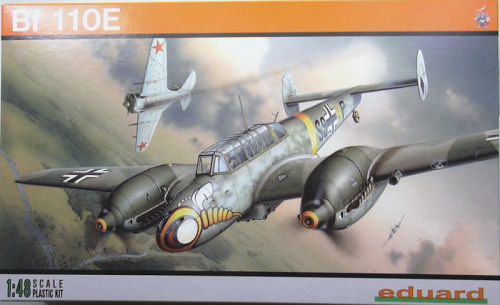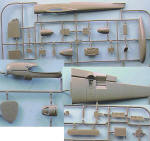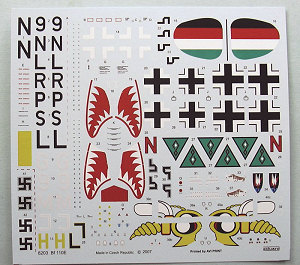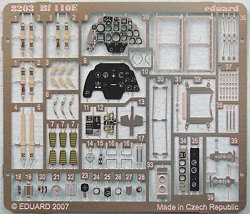
| KIT: | Eduard 1/48 Bf-110E |
| KIT #: | 8203 |
| PRICE: | $49.95 MSRP |
| DECALS: | Four options |
| REVIEWER: | Tom Cleaver |
| NOTES: | New mold kit |

| HISTORY |
One of the well‑known "facts" regarding aviation development during the Second World War is that the Messerschmitt Bf‑110 series was "a compromise in conflicting requirements, resulting in a mediocrity," with a combat performance that relegated it to being considered a "humiliating failure." As with many well‑known "facts" like this, there is a kernel of truth in the charge; but when it is examined in detail it is shown to be a judgement based on wartime priorities of propaganda, and further proof that if a lie is repeated often enough by a sufficientnumber of “experts," without its being pointed out as a lie, it becomes "the truth." The truth about the Bf‑110 series is that there are few aircraft in the history of aircraft development that have been more maligned more unjustly.
The "kernel of truth" in the charge against the Bf‑110 lies in the pre‑war propaganda the airplane was subject to, and its incorrect deployment during two months of the Battle of Britain.
Termed a Zerstoerer, or "Destroyer", by the Luftwaffe, the pre-war image of the Bf‑110 was that of a long‑range bomber escort penetrating deep into enemy territory and brushing aside all opposition. Employed in this capacity during the Battle of Britain, the Bf‑110 was shown to be unable to compete in terms of maneuverability and acceleration against the Spitfire and the Hurricane, with the single‑engine Bf‑109s being called in to defend the escorts as well as the bombers. In truth, no Second World War twin‑engine fighter could hold its own in a dogfight with a well‑flown single‑engine fighter; the most successful - the P‑38 Lightning - was only successful when it stuck to dive‑and‑zoom tactics against its opponents and stayed well away from the close‑in high‑g maneuvering of a dogfight.
In fact, the primary design role of the Bf‑110 had been that of bomber destroyer, and in this role it was outstandinglysuccessful, from its first interception of 18 RAF Wellingtons off the Heligoland Bight on December 18, 1940, when four of the eight bombers shot down were credited to the Bf‑110s of I/ZG76, to March 31, 1944, when 200 Bf‑110s went up against 795 Lancasters and Halifaxes attacking Nuremburg and shot down 94 of them. Two Bf‑110 pilots had scores over 100 ‑ Heinz‑Wolfgang Schnaufer (121) and Helmut Lent (102) ‑ with a hundred others having scores over 30.
Commencing with the Bf-110C, the airplane was also utilized as a schnell jagdbomber or fast fighter-bomber, first entering this role with Erprobungskommando 210, which was later designated Schnellkampfgeschwader (SKG) 210, which saw considerable action on the Eastern Front in 1941-42. The airplane saw combat in all theaters in which the Luftwaffe was engaged.
| THE KIT |
 Fujimi first released an early-series Bf-110 about 30 years ago, with the kit
being released over the years as a Battle of Britain Bf-110C, a long-range
Bf-110D, and a Bf-110E fighter-bomber. The kit was good for its time, though
dimensionally the rear fuselage was too thin. Other than the Revell kits of the
later Bf-110G series, this was the only early-series Bf-110 available until the
release of this new kit by Eduard.
Fujimi first released an early-series Bf-110 about 30 years ago, with the kit
being released over the years as a Battle of Britain Bf-110C, a long-range
Bf-110D, and a Bf-110E fighter-bomber. The kit was good for its time, though
dimensionally the rear fuselage was too thin. Other than the Revell kits of the
later Bf-110G series, this was the only early-series Bf-110 available until the
release of this new kit by Eduard.
According to Vladimir Sulc, the owner of Eduard, the company’s new strategy is
to issue kits of well-known subjects - such as the Fokker D.VII, the I-16, the
Fw-190 - and make their kit “definitive,” i.e., as accurate as possible, with as
much detail as possible, thus achieving a new standard of excellence. This has
been accomplished with the previous releases, and this new Bf-100E follows its
predecessors in accuracy and detail. The Fujimi kit can now be considered
completely obsolete and only preferable if price is the sole consideration.
While the kit is released as a Bf-110E, the Jabo version that entered production in late August 1940, there are parts in the box that allow a modeler to make a Bf-110C or Bf-110D.
 The
overall level of detail is outstanding. The cockpit is so well detailed that no
one will need to consult the aftermarket for a resin replacement. The photoetch
provides the instrument panels, seat belts and other small details. The canopy
comes in both open and closed alternatives and is sparkling clear.
The
overall level of detail is outstanding. The cockpit is so well detailed that no
one will need to consult the aftermarket for a resin replacement. The photoetch
provides the instrument panels, seat belts and other small details. The canopy
comes in both open and closed alternatives and is sparkling clear.
The decals are up to Eduard’s usual standard and provide four different aircraft, including an SKG-210 airplane with the famous Wasp insignia on the nose.
Test fitting shows that the kit is fully up to the standards established with previous releases.
| CONCLUSIONS |
This new Bf-110E is another winner from Eduard that establishes the company as one of the Big Four in the industry, the others being Tamiya, Hasegawa, and Trumpeter. The Bf-110 is a graceful airplane and this model will look good when completed, sitting on the shelf next to the Revell night fighter. Highly recommended.
Thanks to Eduard for the review sample.
August 2007
If you would like your product reviewed fairly and quickly by a site that has 400,000 visitors a month, please contact me or see other details in the Note to Contributors.